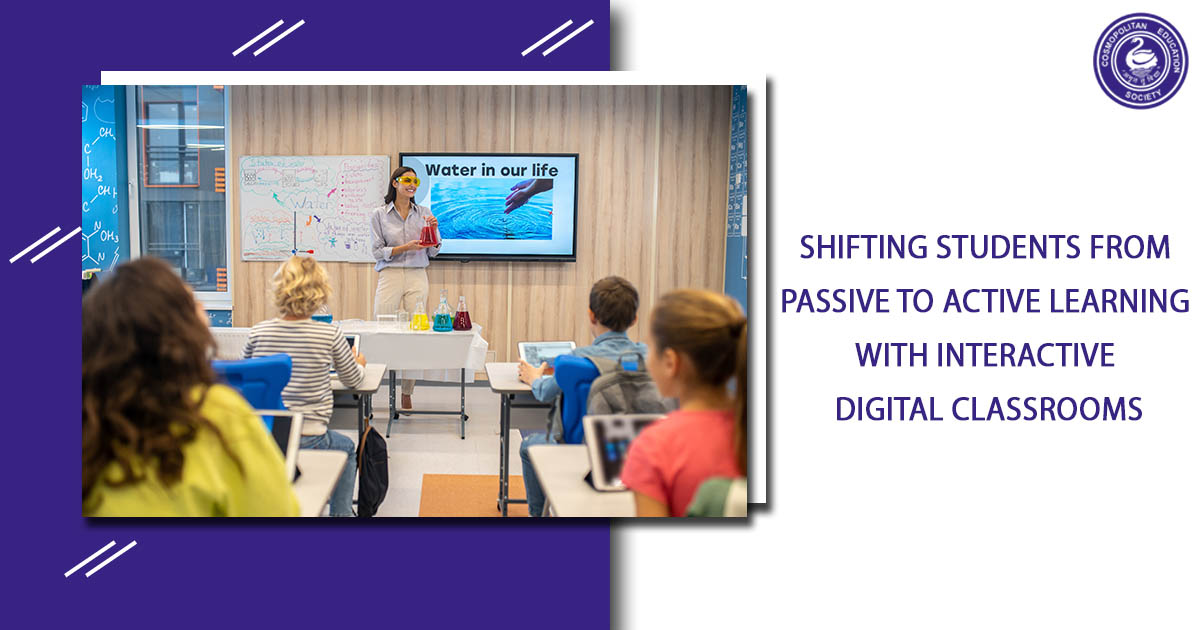
Shifting Students from Passive to Active Learning with Interactive Digital Classrooms
In the ever-evolving landscape of education, traditional teaching methods are gradually giving way to innovative approaches that prioritize student engagement and boost participation. One of the most promising advancements in this direction is the emergence of interactive digital classrooms. These technology-driven learning environments are designed to transform passive learners into actively participating, fostering more understanding, collaboration, and critical thinking.
Keeping gen Z and their technological bend in mind let’s explore how interactive digital classrooms are revolutionizing education
1. Engagement through Interactivity:
Traditional classrooms often revolve around lectures where instructors deliver information, leaving students in a passive role as mere prospects. This approach can lead to disengagement, boredom, and a limited grasp of the material. Interactive digital classrooms, on the other hand, encourage engagement through various means like real-time polls, quizzes, interactive presentations, and virtual discussions. These activities require active participation, keeping students invested in the learning process.
2. Personalized Learning:
Every student has a unique pace and style of learning. Interactive digital classrooms cater to this diversity by allowing students to learn at their own pace. They can pause, rewind, and review content as needed, ensuring a thorough understanding before moving forward. Moreover, digital platforms often incorporate adaptive learning technologies, which analyze individual performance and provide customized content suggestions, addressing each student’s specific learning needs.
3. Enhanced Collaboration:
In traditional classrooms, collaborative activities might be limited to group projects or classroom discussions. Interactive digital classrooms, however, break down geographical barriers, enabling students to collaborate with peers from around the world. Virtual breakout rooms, discussion forums, and collaborative online projects foster teamwork and expose students to diverse perspectives, enhancing their social and cultural awareness.
4. Active Problem Solving:
The essence of education lies not just in memorizing facts but in developing problem-solving skills. Interactive digital classrooms provide ample opportunities for students to tackle real-world problems. Platforms often integrate simulations and interactive scenarios, allowing students to apply theoretical concepts in practical contexts. This active problem-solving approach nurtures critical thinking and analytical skills, preparing students for the complexities of the modern world.
5. Instant Feedback and Assessment:
Waiting for assignments to be graded can slow down the learning process. Interactive digital classrooms offer real-time feedback, allowing students to gauge their progress immediately. Quizzes and assessments are often automated, giving students the chance to identify their strengths and weaknesses swiftly. This feedback loop enables them to adjust their learning strategies and focus on areas that need growth.
6. Lifelong Learning and Flexibility:
The course of learning doesn’t end with formal education; it’s a lifelong endeavour. Interactive digital classrooms instil a sense of curiosity and continuous learning. With resources available online 24/7, students can explore subjects of interest beyond their curriculum, nurturing a growth mindset. Additionally, the flexibility of digital learning accommodates students’ diverse schedules, making education accessible to working professionals and individuals with various commitments.
7. Preparation for the Digital Age:
In today’s digital world, ability with technology is a valuable skill. Interactive digital classrooms equip students with digital literacy and tech-savviness, essential for success in their future careers. Familiarity with digital collaboration tools, online research techniques, and multimedia presentation skills prepares them for the demands of the modern workplace.
In a Nutshell:
Interactive digital classrooms are at the forefront of transforming education from a passive experience to an active, engaging journey. By leveraging technology, these classrooms empower students to take ownership of their learning, fostering critical thinking, collaboration, and problem-solving skills. As the world continues to evolve, so should our educational methods, and interactive digital classrooms offer a promising path toward a more engaging and successful learning experience.
At Harshad Valia International School we ensure in this highly digitalized educational approach, as parents and a reputed teaching institute we need to cater to raising digitally responsible kids for an enhanced digital journey.
